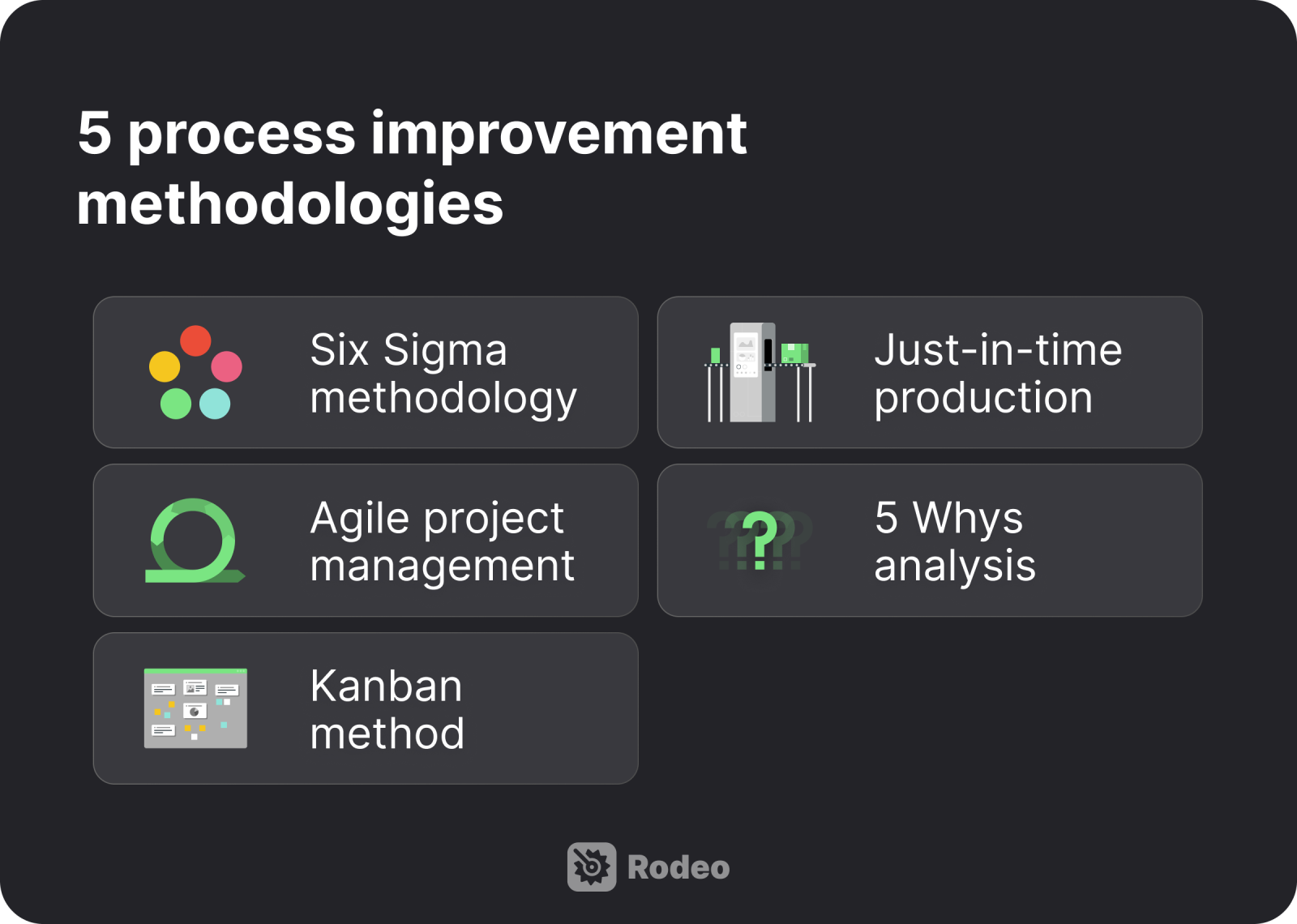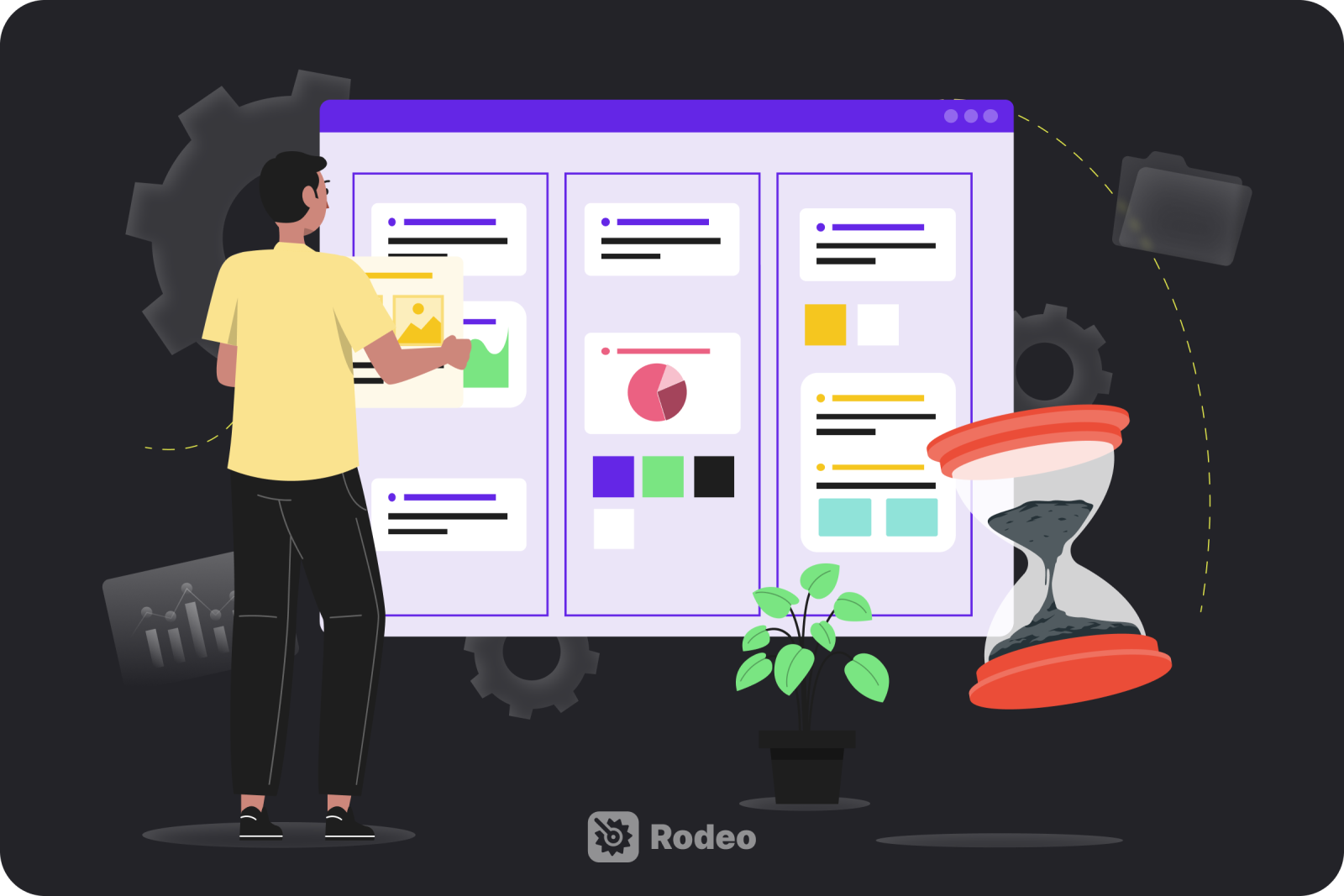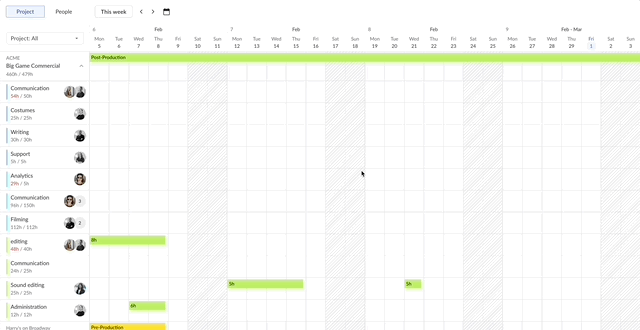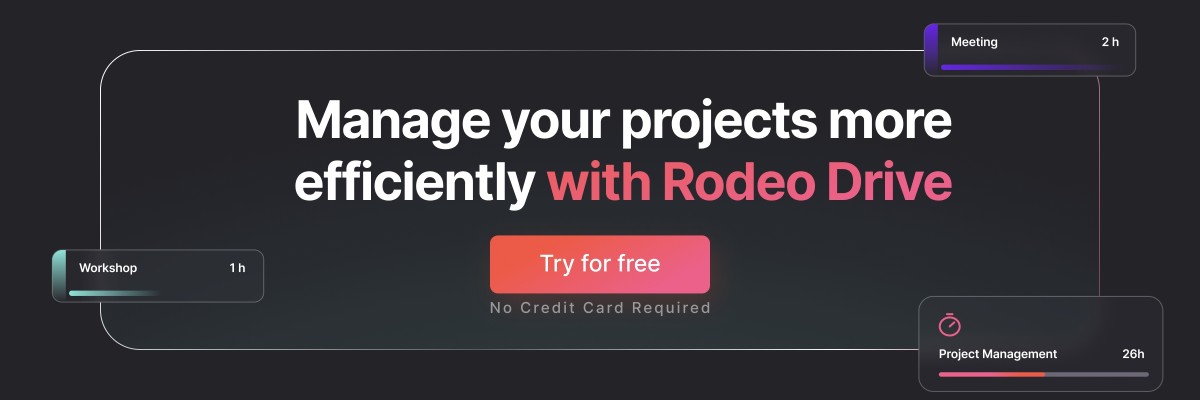5 Process Improvement Methodologies and When to Use Them
Part of becoming a better project manager is developing a knack for process optimization. As you lead more projects, you’ll naturally discover some processes that work, but also others that need improvement.
When it comes to processes that tend to block your team’s progress, using a structured process improvement methodology can help eliminate inefficiencies and overcome hurdles. Meaning, you can use the following approaches to increase your team’s productivity and the quality of their deliverables.
In this article, we’ll cover five process improvement methodologies project managers can use to lead projects to greater success.
What are process improvement methodologies?

In simple terms, process improvement methodologies are ways for teams to make the tasks they do frequently more efficient. These methodologies help companies improve their operations, boosting the quality of their deliverables and overall performance.
Process improvement methodologies are systematic — they are step-by-step frameworks for assessing and refining the repetitive processes that make up the operations of an organization.
It starts with mapping all of a team’s existing processes to get a birds-eye view of the current state of operations. This establishes the baseline from which improvements can be measured.
Following this, the evaluator needs to focus on identifying inefficiencies — time-consuming bottlenecks, redundant tasks, and any other parts of processes that do not add value to the outcome of projects. This identification phase reveals the hidden costs of outdated practices.
Next, comes brainstorming improvements. Here, the organization will get domain experts or a project team together to find practical solutions aimed at overcoming identified inefficiencies.
Once they’ve narrowed down a list of actionable improvements, those improvements can be implemented, often on a small scale or with a proof of concept, to validate their feasibility. This sort of validation makes it possible to fine-tune and iterate process improvements based on real-world feedback. You can scale up those improvements once they’re proven.
The final step involves monitoring the improvements, making sure the new processes are effective over time, and meeting desired KPIs.
Also read: Top 12 Project Management Methodologies to Keep Teams on Track
Benefits of implementing a process improvement methodology
Knowing the basics of process improvement, it’s natural to question the impact these strategies have after they are implemented. Well, there are several direct benefits to undertaking process improvements. Here are three of the main ones:
Improved Efficiency
An immediate benefit of implementing a process improvement methodology is the leap in efficiency it facilitates. By carefully assessing their processes, organizations can eliminate wasteful steps, reduce the time it takes to complete tasks, and ultimately increase their output. This translates into the ability to deliver projects faster and within budget.
Enhanced Quality
Process improvement methodologies play a pivotal role in enhancing the quality of project deliverables. A lot of this comes down to reducing the variability in processes by introducing standards for how tasks should be done. Overall, this can reduce errors and improve the consistency of project deliverables.
Increased Profitability
Together, improved efficiency and quality have a direct impact on the profitability of projects. Achieving high-quality deliverables, on time, positions your organization to reduce operational costs and drive up project profit margins.
5 process improvement methodologies to consider implementing
Having gone through process improvement methodologies and their benefits in general terms, it’s time we get into the methodologies themselves. Each of the following methods offers a tailored approach to tackling challenges unique to different kinds of projects.

Six Sigma methodology
Six Sigma is a data-driven approach aimed at minimizing defects and reducing the variability in processes. For this reason, it’s commonly used in manufacturing. Six Sigma uses statistical analysis to benchmark processes, helping project managers find the root causes of defects, measure performance, and prioritize the most impactful improvements.
The Six Sigma methodology can be performed through two frameworks DMAIC (Define, Measure, Analyze, Improve, Control) for existing processes and (Define, Measure, Analyze, Design, Verify) for new processes. Since we’re focused on process improvement, we’ll just cover the DMAIC framework.
What is the DMAIC process?
Let’s elaborate on what each of the items in DMAIC stands for:
- Define what can be improved
- Measure the performance of current processes
- Analyze the process to find inefficiencies and blockers
- Improve processes by addressing the cause of inefficiency
- Control improved processes and benchmarks to maintain heightened performance
Analysis is typically the most resource and time-consuming part of Six Sigma process improvements. Teams commonly use the Taguchi method or an Ishikawa diagram when conducting their analysis. Each makes it easier to understand dependencies and the root cause of defects in a process.
Agile project management
Agile project management is an approach where project requirements and solutions evolve through the effort of self-organizing teams. As teams produce deliverables through sprints, they put their outputs through feedback cycles with customers, iterating on them to reflect that feedback. With an agile approach, work is delivered in small increments, making it easy to quickly adjust outputs before moving on to the next phases of a project.
The benefit of agile is it’s continuous. It encourages constant review of your processes and results, helping ingrain process improvement into your team’s workflow.
Kanban method

Originating from the Japanese manufacturing sector, the Kanban method has found its way into various industries as a powerful tool for visual workflow management.
In terms of process improvement, Kanban is useful because it uses visual cards and boards so teams can map out their current processes and see bottlenecks physically.
Kanban is easy to use and adaptable. Since it’s a simple visual tool, it can be paired with other process improvement methodologies, helping translate some of the more complex approaches into something easy to understand.
Related: Kanban vs Scrum: Understand the Difference
Just-in-time production
Just-in-Time (JIT) production is a process improvement methodology associated with lean manufacturing. It aims to reduce waste in processes by focusing on only what is needed — similar to the idea of a critical path in project management.
Through this form of analysis, you can ‘trim the fat’ out of projects by removing extraneous tasks and things that are nice to have but not essential. This reduces project costs by keeping scope only focused on what’s imperative.
The JIT process improvement has five steps:
1. Identify the value of the project, typically through an analysis of what each of your stakeholders finds the most important.
2. Map the value stream by diagraming your current workflow. Identify redundant tasks, perhaps using the previously mentioned Kanban system.
3. Create flow by reworking your project management plans to eliminate the waste identified in step two.
4. Establish a pull system by easing the movement of work from previous project phases into the next. This usually looks like putting in place approval processes that signal work is completed up to standard and ready to use in the next phase.
5. Continuously improve by repeating the process and periodically reassessing your workflow.
5 Whys analysis
The 5 Whys method is a straightforward yet powerful framework for finding the root cause of a problem. It’s a method of first principles thinking where you break down a complex problem into basic elements by asking “why” five times. By doing so, teams can look past the surface level to understand the deeper reasons a process isn’t working.
Say, for example, a team struggles to deliver software projects on time. Using the five whys, they could evaluate the issues in their project management in the following way:
- Why was the project late? Because several deliverables were more time-consuming than anticipated.
- Why were those deliverables more time-consuming than anticipated? Because we didn’t have an accurate way to measure how much time they would take.
- Why doesn’t the team have an accurate way to measure how much time deliverables take? Because we currently only use rough estimates of how much time it takes to complete those deliverables.
- Why do you only use rough estimates of how much time it takes to complete deliverables? Because we don’t have accurate data for how much time those deliverables should actually take.
- Why don’t you have accurate data on how much time to complete deliverables? Because we don’t collect data on how long it takes us to complete deliverables.
Like that, the team learns the core problem isn’t about how time-consuming their deliverables are, but rather how they don’t collect enough data to set accurate timelines for their projects.
Key challenges in implementing process improvement methodologies

Implementing process improvement methodologies is not without challenges. Changing longstanding practices presents many roadblocks that can impede progress and dampen morale. Understanding some of these challenges is the first step in mitigating their impact.
Resistance to change: One of the most pervasive challenges is the human element—resistance to change. Employees may be wary of new methodologies, fearing increased workload or changes to their roles. Overcoming this requires clear communication, emphasizing the benefits of changes, and providing reassurance and support throughout the transition.
Scaling methodologies: What works in one team or department may not seamlessly translate across an organization. You’ll need to carefully plan and assess methodologies to make sure they work in the different contexts within your organization without losing effectiveness.
Sustaining improvements: Initial successes can be quickly overshadowed by a return to old habits. Making sure changes stick and maintaining momentum is important for changes to succeed in the long run.
Measuring the success of process improvements

The true measure of any process improvement methodology lies in its tangible benefits to the organization. Success metrics or OKRs should be established at the outset, tailored to the specific goals of the process improvements. Examples can be as such:
Efficiency gains: Reductions in process times and increased throughput are clear indicators of improved efficiency. Tracking these changes can demonstrate the direct impact of process improvements.
Quality improvements: Enhanced quality can be measured through success criteria like reduced error rates, fewer customer complaints, and higher satisfaction scores.
Financial performance: Ultimately, the bottom line speaks volumes. Increased profitability, cost savings, and return on investment (ROI) are compelling metrics that justify the adoption and continued application of process improvement methodologies.
Related: How to Track Project Expenses Effectively
Employee engagement: While harder to quantify, increased employee engagement is a significant indicator of success. Engagement means employees are on board with the changes and taking the initiative to keep them in place.
Improve your processes with the help of a work management tool
Rodeo Drive is purpose-built to complement the efforts of creative teams engaged in project-based work. It’s designed to simplify project planning, budgeting, invoicing, and progress reporting. Also, because every feature in Rodeo Drive is integrated with your project’s budget, you can easily manage the finances and profitability of your projects without being an expert.
Here are two of Rodeo Drive’s standout features that’ll make your project management easier than ever.
Activity planning and capacity Management
Rodeo Drive’s timeline-view planner empowers you to set realistic goals and evenly distribute workloads. Using the planner, you can supervise team activities across multiple projects or on an individual basis, giving you a holistic view of team commitments. The core features of the planner are:
- Visual assignment tools that allow you to assign activities in a few clicks, or adjust project plans with an intuitive drag and drop.
- People-centric capacity management through an innovative people-view planner, enhancing the granularity with which you can oversee team capacity. The people planner is a day-by-day, visual indicator system — displaying green checkmarks when a team member is optimally allocated for a day and red markers when they’re overloaded – which provides an at-a-glance awareness of team members’ availability.

The timeline planner’s UI is easy to navigate and adjust.
Reporting tools that facilitate process improvement
Rodeo Drive has three main reporting views: time, productivity, and projects. These reports provide enough oversight to identify inefficiencies and improve processes.
For example, the time reports allow you to see the cost of individual project activities, allowing you to see if certain activities are incurring more expenses than expected or are time-inefficient. You can use these insights to identify obstacles and adjust your processes accordingly.
.png)
Track all billable activities using Rodeo Drive’s time reports
Diverse reporting which delivers insights into how team members use their time, billable and non-billable, as well as the overall financial performance of each of your projects.
Exportable data for custom analysis which gives flexibility for custom reports. Easily export data from Rodeo Drive as Excel or CSV files to build tailored reports. Use this data for specific analysis or for data to support your process improvement initiatives.
Some agencies have increased their project profitability by 30% through Rodeo Drive. Yours can be next. Start using Rodeo Drive for free, no credit card required.








